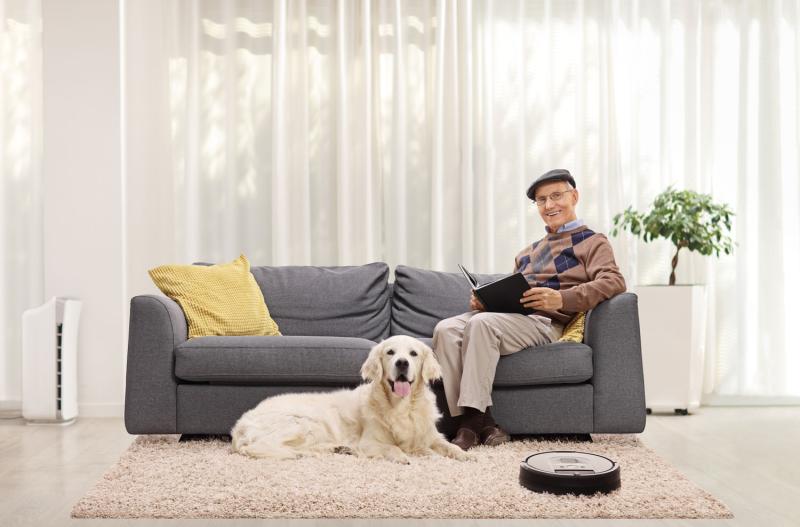Key points
- Assistive technologies are products and services that can enhance support, prompt carers to intervene when necessary, and monitor safety, allowing people with dementia to maintain their involvement in activities while keeping safe.
- The research on assistive technologies is still relatively new. However, family carers are often recommended the use of assistive technology, especially that which supports safety and security for people living with dementia.
- In the community setting, evidence supports the use of night monitoring systems such as bed exit alarms, tracking devices, and automatic night lights to reduce falls and exits from the home.
- The effectiveness of assistive technologies in reducing agitation and the falls rate in residential care is inconclusive.
Assistive technology is a broad term covering products and services with the potential to:
- Enhance support and care
- Act as a prompt for interventions by carers
- Monitor safety and welfare
- Assist in communication and leisure activities for a person with dementia. [1]
Assistive technologies may therefore allow people with dementia to maintain their function, stay safe, and continue to participate in activities they enjoy. [2] Examples of simple devices include prompts and reminder systems, stove and tap shutoff devices, personal alarms, safety mats, and monitoring systems for falls, bed or door exits, or inactivity. [2] More high-tech solutions include global positional satellite (GPS) tracking for people who may wander and get lost and smart home setups which allow people to control appliances, thermostats, lights, and other devices remotely. These technologies can be found in both home care (e.g., GPS and monitoring devices, smart home tech) and residential aged care (e.g., door sensors, falls detection mats and sensors, tracking devices). There are also various different types of robots that have been developed to assist people with dementia: Companion robots, telepresence communication robots, homecare assistive robots and multifunctional robots. [3]
This evidence theme on assistive technologies is a summary of one of the key topics identified by a scoping review of dementia research. If you need more information on this topic, try using the PubMed search below.
We found 10 systematic reviews examining the relationship between assistive technologies and outcomes for people living with dementia and/or their family carers. Generally, family carers recommended the use of assistive technologies, especially those which support safety and security for people living with dementia. [1]
In the community setting, evidence supports the use of night monitoring systems such as bed exit alarms, tracking devices, and automatic night lights to reduce falls and exits from the home. [4, 5] In the residential care setting, the effectiveness of position sensors for detecting resident attempts to get out of bed or a chair to ambulate is still unclear. [6] Their presence does not seem to influence the rate of falls while their removal in one study resulted in a falls reduction. [4]
The evidence of the effectiveness of assistive technologies is inconclusive for:
- Reducing agitation [3, 6-8]
- Preventing falls and accidents in the residential care setting [5, 9]
- Improving people’s ability to manage self-care. [10]
This is because some studies report benefits of assistive technologies, while others report no benefits. There was no clear evidence of benefit for:
- Quality of life [3, 6, 8]
- Depression [3, 6, 8]
- Cognition [3]
- Reducing admission to residential aged care [5, 6]
- The personal impact of supporting someone with dementia (often referred to as ‘carer burden’) [1]
- Carer wellbeing. [1]
In other words, studies have assessed the relationship between assistive technologies and these outcomes, but no benefit was found. There may also be risks associated with using assistive technologies, with one study finding that a humanoid robot companion increased delusions. [6]
Reviews highlighted concerns about the methods used in some of the studies. This reduces the degree of certainty we might have about the benefits of assistive technologies. For example:
- Some studies only had a small number of participants. [5, 8]
- Studies were not always clear about what the intervention involved [8]
- The long-term benefits of assistive technologies were not clear. [5]
- Potentially important outcomes were not assessed. These include cost-effectiveness, safety issues, and responsive behaviours. There was also little said about the acceptance of these technologies by the person living with dementia, [5, 6] although robot were found to be feasible and acceptable. [3]
- Overall, there was a lack of high-quality evidence examining whether assistive technology is effective in supporting people living with dementia. [11]
- Be familiar with the types of assistive technology available (see resources below).
- Refer/escalate to your line manager any safety-related concerns you may have for a person living with dementia.
- Be familiar with the types of assistive technology available.
- Facilitate staff training about what technology may be available, who it may assist, and how to use it.
- Consider networking or partnering with companies that offer assistive technology products and services. Trial some for their effectiveness.
- Sriram V, Jenkinson C, Peters M. Informal carers' experience of assistive technology use in dementia care at home: a systematic review. BMC Geriatr. 2019;19(1):1-25.
- National Aged Care Alliance. Position paper: Assistive technology for older Australians [Internet]: Australia: NACA; 2018 [cited 2023 Jun 29]. Available from: https://agedcare.royalcommission.gov.au/system/files/2020-06/COT.9999.2222.0008.pdf.
- Yu C, Sommerlad A, Sakure L, Livingston G. Socially assistive robots for people with dementia: Systematic review and meta-analysis of feasibility, acceptability and the effect on cognition, neuropsychiatric symptoms and quality of life. Ageing Res Rev. 2022;78:101633.
- Jensen L, Padilla Re. Effectiveness of environment-based interventions that address behavior, perception, and falls in people with Alzheimer's disease and related major neurocognitive disorders: A systematic review. Am J Occup Ther. 2017;71(5):1-10.
- Brims L, Oliver K. Effectiveness of assistive technology in improving the safety of people with dementia: A systematic review and meta-analysis. Aging Ment Health. 2019;23(8):942-51.
- Chan DKY, Chan LKM, Kuang YM, Le MNV, Celler B. Digital care technologies in people with dementia living in long-term care facilities to prevent falls and manage behavioural and psychological symptoms of dementia: A systematic review. Eur J Ageing. 2022;19(3):309-23.
- Wang G, Albayrak A, van der Cammen TJM. A systematic review of non-pharmacological interventions for BPSD in nursing home residents with dementia: From a perspective of ergonomics. Int Psychogeriatr. 2019;31(8):1137-49.
- Lu LC, Lan SH, Hsieh YP, Lin LY, Lan SJ, Chen JC. Effectiveness of companion robot care for dementia: A systematic review and meta-analysis. Innov Aging. 2021;5(2):igab013.
- Peek K, Bryant J, Carey M, Dodd N, Freund M, Lawson S, et al. Reducing falls among people living with dementia: A systematic review. Dementia. 2020;19(5):1621-40.
- Sampath P, Forbes DA, Barton S, Blake C. A systematic review of the effectiveness of interventions for persons living with dementia based in the home or community. Perspectives. 2015;38(2):6-19.
- Van der Roest HG, Wenborn J, Pastink C, Droes RM, Orrell M. Assistive technology for memory support in dementia. Cochrane Database Syst Rev. 2017;6:CD009627.
Connect to PubMed evidence
This PubMed topic search is limited to home care and residential aged care settings. You can choose to view all citations or citations to articles available free of charge.


